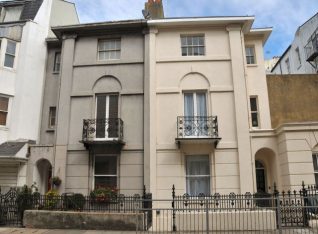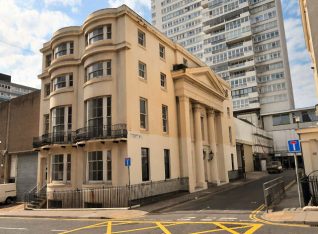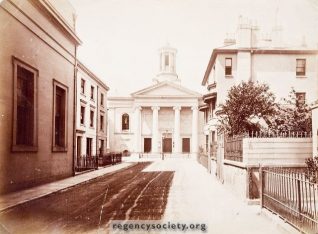Formerly Regency Cottages
St Margaret’s Place, which is off Cannon Place was built in the 1820s and originally called Regency Cottages. The name was changed when St Margaret’s Church was opened, at the end of the road, in 1824.
St Margaret’s Church
The church was designed by Charles Busby for Barnard Gregory, the then editor of the Brighton Gazette. It was named after his wife Margaret, and at the time was considered to be the best classical church in Brighton. With a seating capacity of 1,500 persons, it was second only to St Peter’s Church.

Numbers 2 and 3 St Margaret’s Place

Detail of railings and gate

Former Royal Newburgh Rooms

Undated photograph of St Margaret’s Church
Listed buildings
The houses, which have Ionic pilasters, and railings, at numbers 2-3 on the north side of Cannon Place, are listed and probably by Wilds and Busby. Opposite stands the very grand entrance to the former Royal Newburgh Assembly Rooms, by A.H.Wilds for Charles Wright, also listed, and erected c1833. The entrance facade has two Corinthian columns on either side of the doorway, with a central pediment. William IV is reputed to have attended the opening of the assembly rooms which were a popular social centre for many years.




Comments about this page
I think St Margaret’s was demolished in 1959 (perhaps somebody can confirm this) and replaced by Sussex Heights, the tall block of flats pictured behind the former Royal Newburgh Rooms.
Editor’s note: Yes Alan, St Margaret’s was demolished in June 1959 to make way for Sussex Heights, the Metropole Exhibition Halls, and a 250 space car-park. Thanks – Jennifer
Can you understand why that beautiful building was demolished to make way for a hideous building, which, I believe, was originally intended to house the better off amongst us.
I believe that St Margaret’s was at one time intended, after the end of its life as a church, to be the Brighton Local History Museum. It was lost at a very low point in Brighton’s life when great damage was done to the urban fabric, not just in demolitions but in what replaced the older buildings. Very few structures of that time deserve merit, one being the small development of Brighton Square- it being in scale with the other streets of the Old Town. Suggestions for other success stories?
Just seen this belatedly. The bulk of the 1875 3-manual organ in St Margaret’s by Gray & Davison was rescued at the last moment by Morgan & Smith, and deposited in the South Transept of St Andrew’s, Burgess Hill. Two or three of the best stops (Mixture and reed(s)) had been stolen by then, but nevertheless the organ was eventually rebuilt in St Andrew’s as a 2-manual, by F.H. Browne, where it flourishes to this day.
Just found a report in the The Times (31 July 1958) that indicates St Margaret’s was going to be used to house the costume museum that, after a temporary stay at the Pavilion, ended up in the Bath Assembly Rooms and is now the Fashion Musuem – a huge tourist draw. So that’s a double loss to the city.
Does anyone know why the former Royal Newburgh Rooms, which used to be used as a French and German protestant church, are now lying empty?
Does anyone know anything about the school at 17 Cannon Place opposite St Margaret’s Church? My great grandfather attended it in the 1860s. Mr Harris was the headmaster at the time.
The earliest directory I have is Kelly’s 1914 so some time after the 1860s. In 1914 there are 5 different names attached to that address but nothing about a school. There are 45 addresses in Cannon Place of which 30 are apartments or lodgings. I expect #17 was a similarly large house used as a school at that time in the 1860s.
Older street directories list No. 17 Cannon Place as a ‘young gentleman’s boarding school’, run by Henry Edward Harris from 1846 to 1883. That’s a remarkable run and suggests the school had a good reputation. It looks like the school closed when Mr Harris had died: a Henry Edward Harris died in Brighton, aged 72, at the end of 1882. (Info in street directories can be a year out of date.) It’s possible that the local press carried an obituary of him, which would yield more information.
No. 17 also appears in the 1832 and 1839 Piggots directories under ‘Academies, Seminaries and Public Schools’. In 1832 it was a preparatory school, run by Charlotte Annan. In 1839 it was run by John Annan MA.
The London Evening Standard of 20 Oct 1882 carries a death notice that confirms that Henry Edward Harris died at 17 Cannon Place, Brighton on Oct 17 in his 73rd year.
Interestingly, in May/Jun 1875 the Volunteer Service Gazette and Military Dispatch periodical carried adverts offering “An Alphabetical List of the Officers of the Volunteer Force in Great Britain” complete with each officer’s rank and corps. This tome was only available from the compiler – Lt Henry E Harris of the 1st Sussex RVC at 17 Cannon Place. Clearly this would have been a massive undertaking to produce and a ‘labour of love’ for Henry.
This is all very interesting. My great grandfather said that his school at 17 Cannon Place used to have matches of the game of fives with the boys of the Western College, but I can’t find any sign of that school. Is it part of Brighton College?
Add a comment about this page